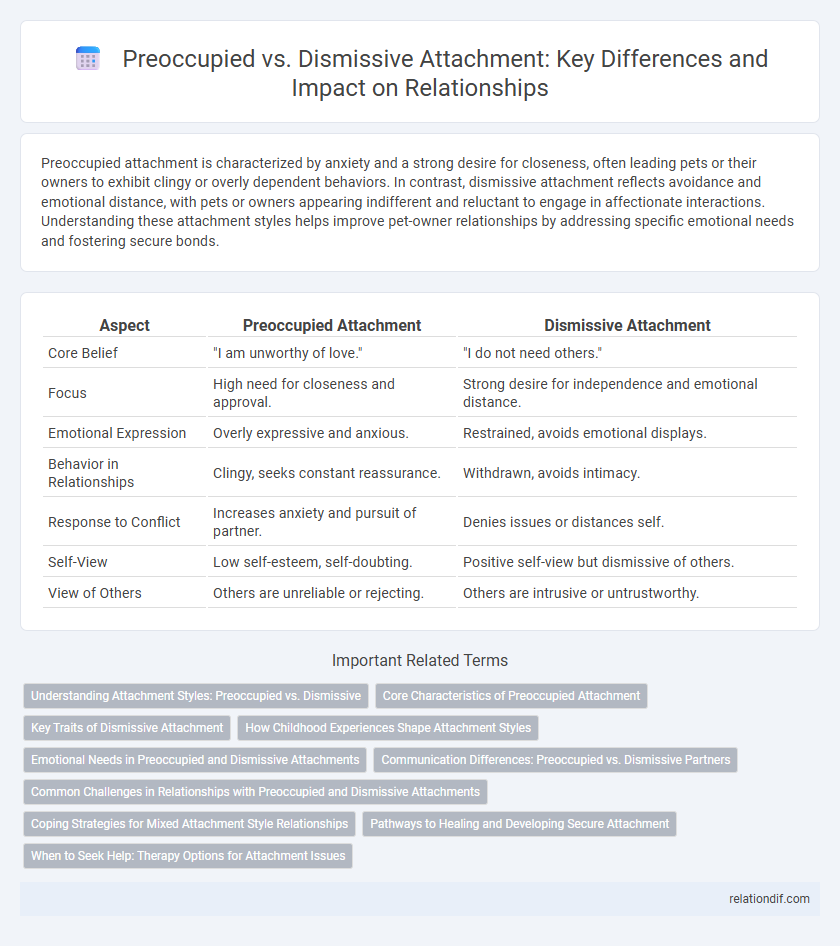Preoccupied attachment is characterized by anxiety and a strong desire for closeness, often leading pets or their owners to exhibit clingy or overly dependent behaviors. In contrast, dismissive attachment reflects avoidance and emotional distance, with pets or owners appearing indifferent and reluctant to engage in affectionate interactions. Understanding these attachment styles helps improve pet-owner relationships by addressing specific emotional needs and fostering secure bonds.
Table of Comparison
| Aspect | Preoccupied Attachment | Dismissive Attachment |
|---|---|---|
| Core Belief | "I am unworthy of love." | "I do not need others." |
| Focus | High need for closeness and approval. | Strong desire for independence and emotional distance. |
| Emotional Expression | Overly expressive and anxious. | Restrained, avoids emotional displays. |
| Behavior in Relationships | Clingy, seeks constant reassurance. | Withdrawn, avoids intimacy. |
| Response to Conflict | Increases anxiety and pursuit of partner. | Denies issues or distances self. |
| Self-View | Low self-esteem, self-doubting. | Positive self-view but dismissive of others. |
| View of Others | Others are unreliable or rejecting. | Others are intrusive or untrustworthy. |
Understanding Attachment Styles: Preoccupied vs. Dismissive
Preoccupied attachment is characterized by anxiety about relationships, leading to clinginess and heightened sensitivity to rejection, while dismissive attachment involves emotional detachment and a strong desire for independence. Individuals with preoccupied attachment often seek approval and fear abandonment, contrasting with dismissive types who downplay the importance of close connections to protect themselves from vulnerability. Recognizing these distinct patterns aids in improving interpersonal dynamics and fostering healthier emotional bonds.
Core Characteristics of Preoccupied Attachment
Preoccupied attachment is characterized by an intense desire for closeness, coupled with anxiety about relationship security and fear of abandonment. Individuals with preoccupied attachment often exhibit hypervigilance to social cues and heightened emotional reactivity, leading to dependency and difficulty trusting partners. This attachment style is linked to internalized feelings of unworthiness, driving a persistent need for validation and approval in interpersonal connections.
Key Traits of Dismissive Attachment
Dismissive attachment is characterized by emotional detachment, a strong sense of independence, and reluctance to rely on others for support. Individuals with this style often minimize the importance of relationships and suppress their own emotional needs. Their key traits include a preference for self-sufficiency, avoidance of intimacy, and a tendency to downplay or dismiss feelings.
How Childhood Experiences Shape Attachment Styles
Childhood experiences of inconsistent caregiving often lead to preoccupied attachment, characterized by heightened anxiety and a persistent need for approval and closeness. In contrast, dismissive attachment develops from early emotional neglect or rejection, resulting in emotional self-reliance and avoidance of intimacy. These attachment styles are deeply rooted in early interactions with primary caregivers, shaping patterns of relating and emotional regulation throughout life.
Emotional Needs in Preoccupied and Dismissive Attachments
Preoccupied attachment is characterized by heightened sensitivity to emotional needs, where individuals intensely seek validation and reassurance to feel secure in relationships. Dismissive attachment, in contrast, involves suppression of emotional needs, leading individuals to prioritize independence and often avoid intimacy to protect themselves from perceived vulnerability. Understanding these contrasting approaches to emotional needs is crucial for addressing relationship dynamics and fostering healthier emotional connections.
Communication Differences: Preoccupied vs. Dismissive Partners
Preoccupied attachment manifests in communication through heightened emotional expression and seeking reassurance, whereas dismissive attachment leads to emotional distance and minimal self-disclosure. Preoccupied partners often interpret ambiguous messages as threats and engage in persistent dialogue, while dismissive individuals avoid vulnerability and may downplay issues. These contrasting patterns create challenges in mutual understanding, with preoccupied individuals desiring closeness and dismissive ones prioritizing independence.
Common Challenges in Relationships with Preoccupied and Dismissive Attachments
Preoccupied attachment commonly results in anxiety over abandonment, leading to clinginess and excessive reassurance-seeking that can strain relationships. Dismissive attachment causes emotional distance and a reluctance to express vulnerability, often creating barriers to intimacy and unresolved conflicts. Both attachment styles frequently struggle with trust and effective communication, causing cycles of misunderstanding and frustration in partnerships.
Coping Strategies for Mixed Attachment Style Relationships
Preoccupied attachment individuals cope with mixed attachment style relationships by seeking reassurance and maintaining emotional closeness, often displaying hyper-vigilance to signs of rejection. Dismissive attachment partners tend to manage conflict by distancing themselves emotionally and valuing independence, which can create challenges in mutual understanding. Effective coping strategies include open communication that balances emotional needs with autonomy, fostering security through consistent responsiveness and setting clear boundaries.
Pathways to Healing and Developing Secure Attachment
Preoccupied attachment manifests through heightened emotional dependency and fear of abandonment, requiring therapy focused on emotional regulation and building self-worth to develop secure attachment patterns. Dismissive attachment is characterized by emotional distancing and self-reliance, with healing pathways centered on increasing emotional awareness and fostering vulnerability in relationships. Both styles benefit from consistent, supportive caregiving and attachment-based interventions to promote trust and resilience in forming secure bonds.
When to Seek Help: Therapy Options for Attachment Issues
Individuals with preoccupied attachment often benefit from therapy that focuses on building self-awareness and emotional regulation, such as cognitive-behavioral therapy (CBT) or dialectical behavior therapy (DBT). Those with dismissive attachment may find success in therapies that emphasize developing trust and vulnerability, including psychodynamic therapy or emotion-focused therapy (EFT). Seeking help is crucial when attachment patterns lead to chronic anxiety, relationship difficulties, or impaired emotional functioning, and therapists specialized in attachment theory can tailor interventions to address these specific needs.
Preoccupied attachment vs dismissive attachment Infographic

 relationdif.com
relationdif.com